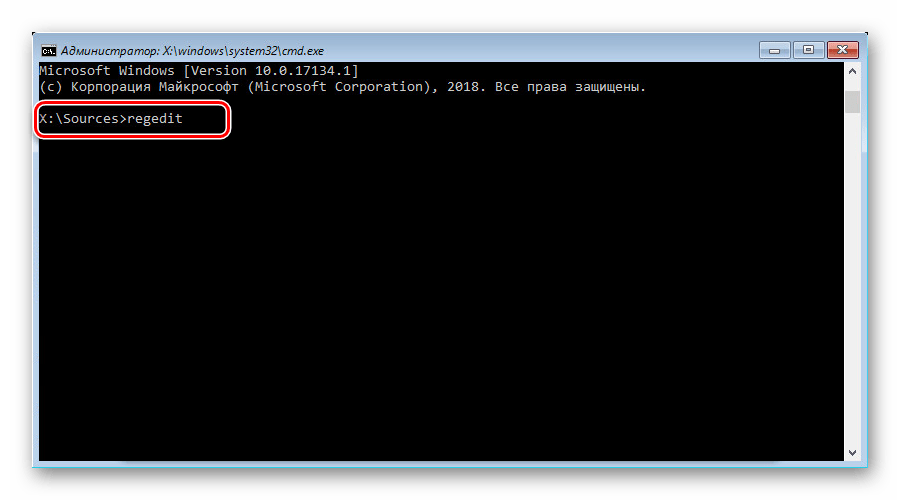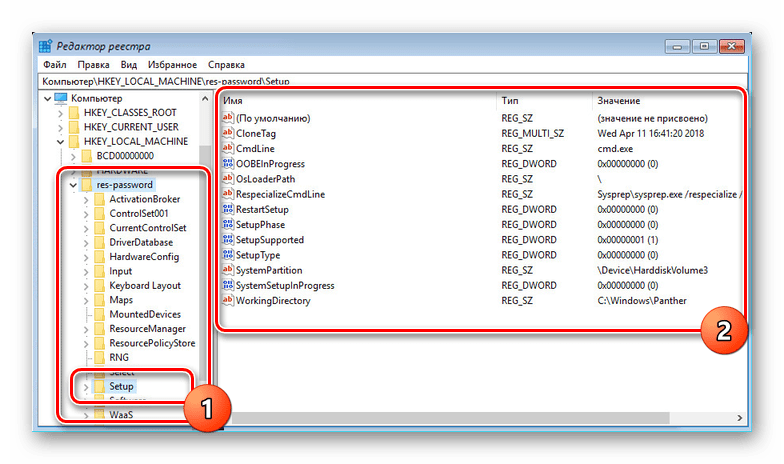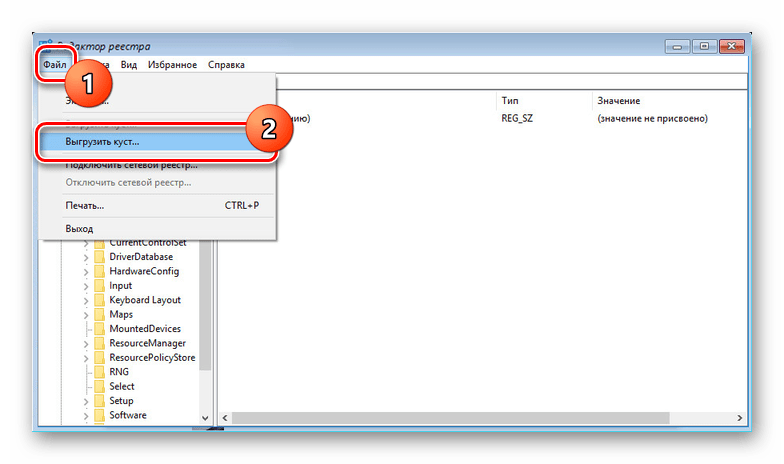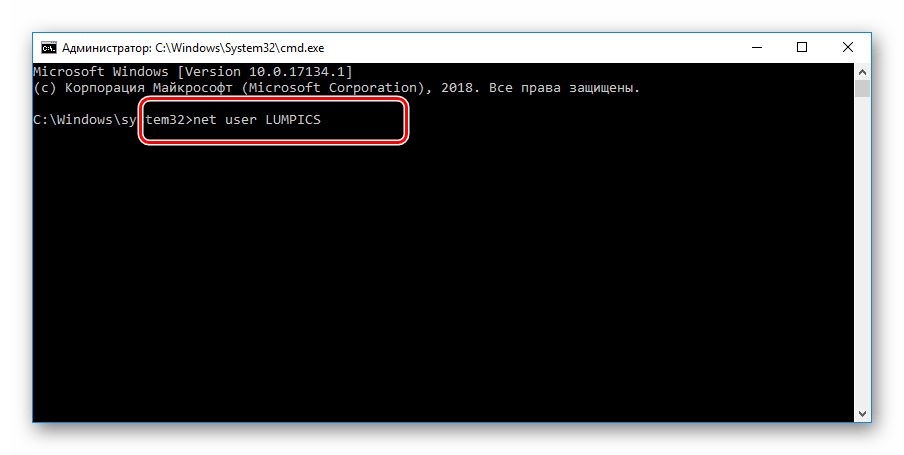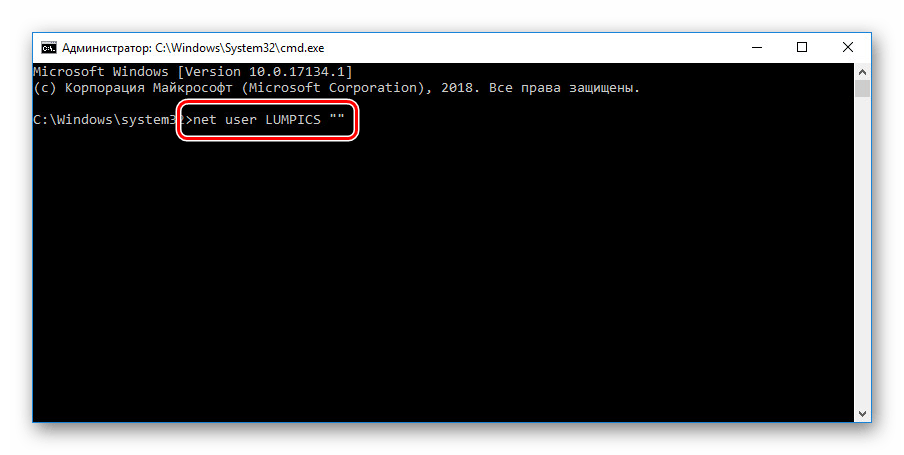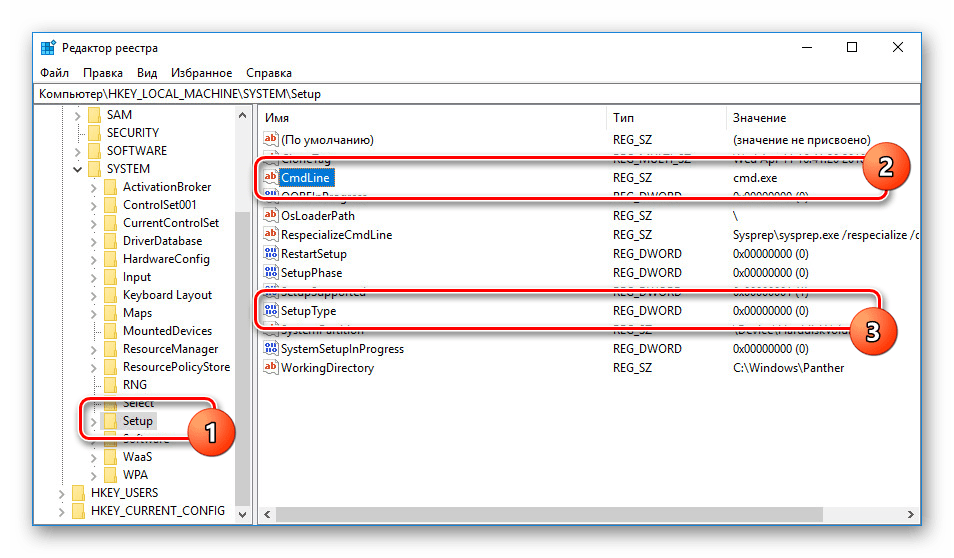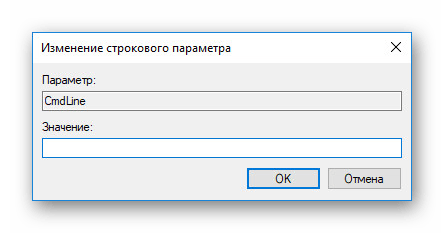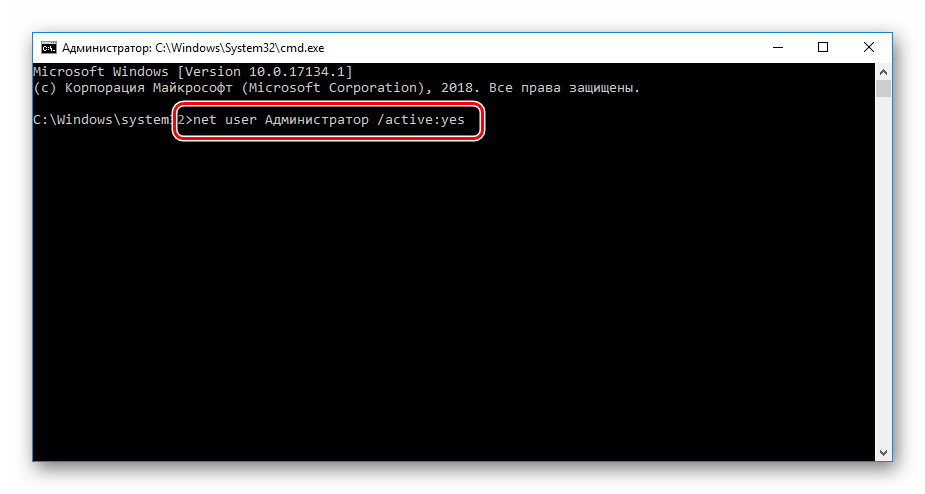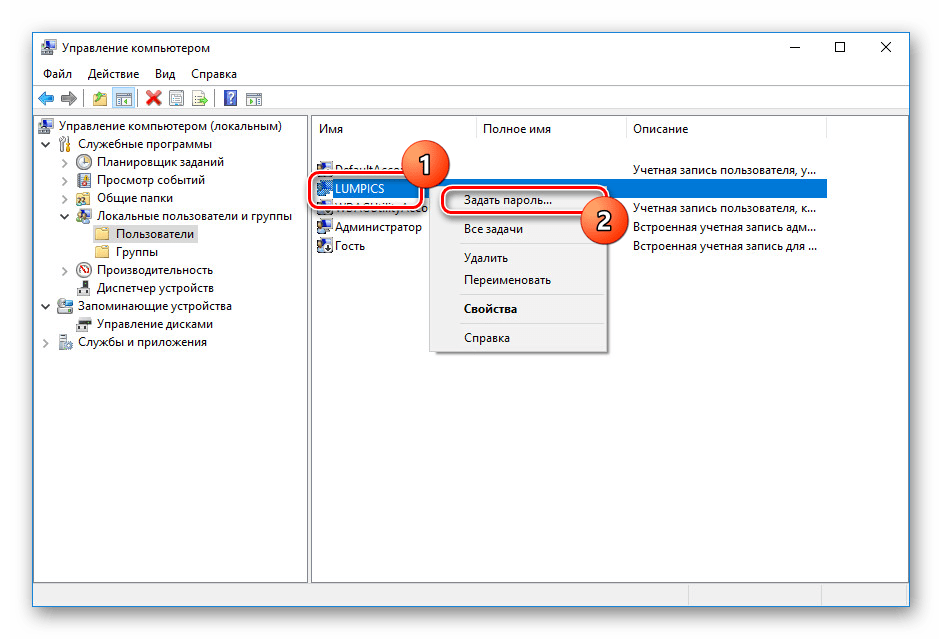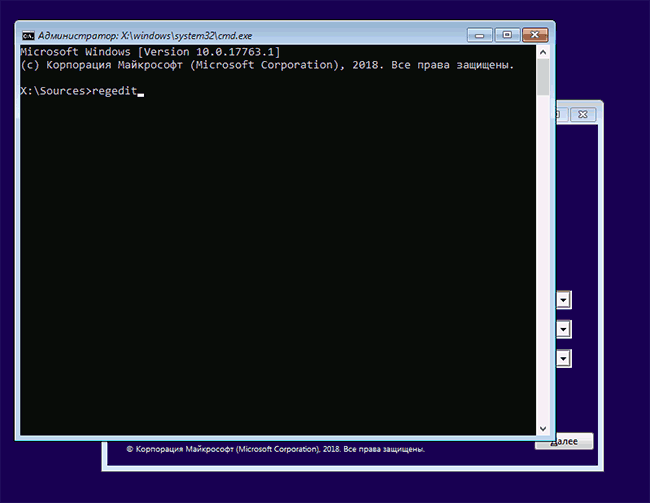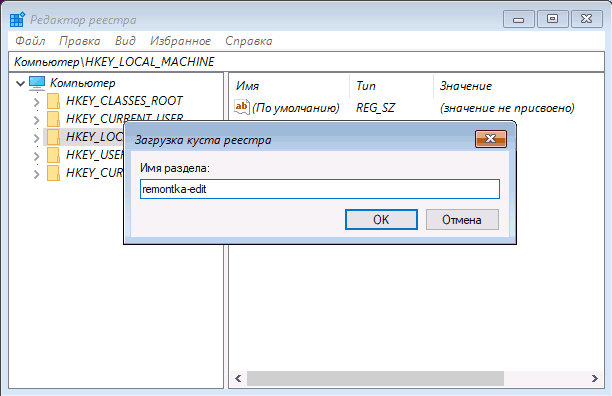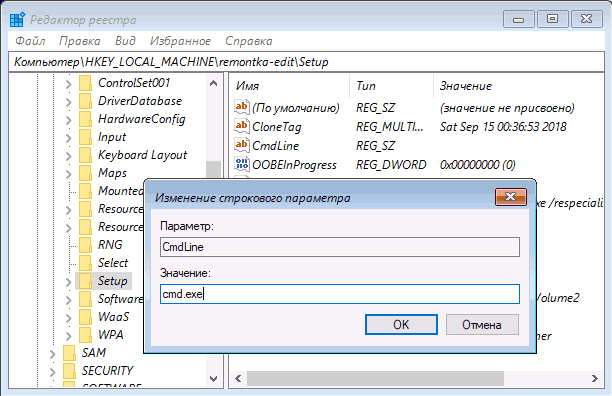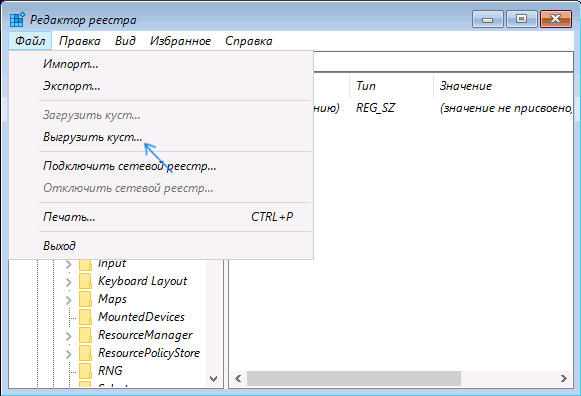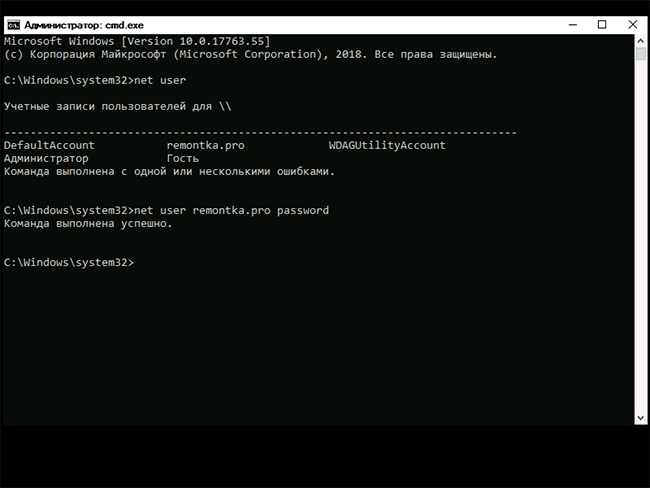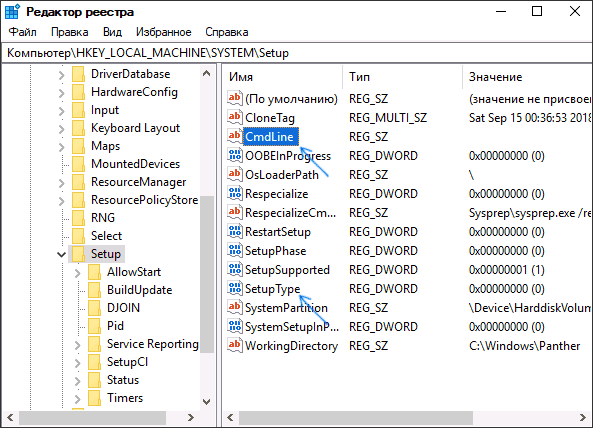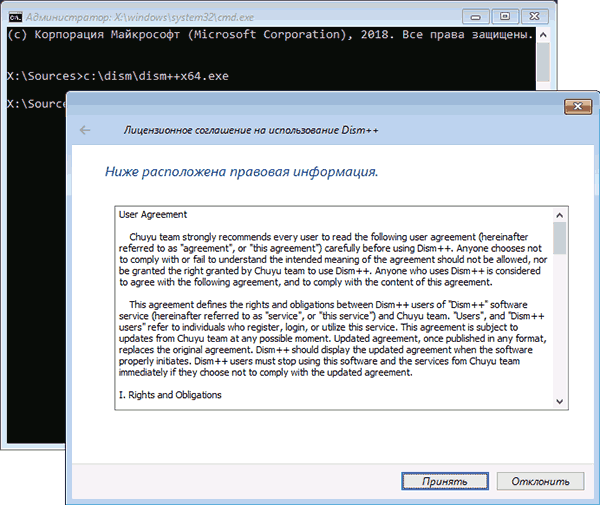Все способы:
- Сброс пароля в Windows 10 через «Командную строку»
- Способ 1: Редактирование реестра
- Способ 2: Учетная запись администратора
- Вопросы и ответы: 15
В операционной системе Windows 10 помимо дополнительных средств идентификации также существует обычный текстовый пароль по аналогии с предыдущими версиями ОС. Нередко подобного рода ключ забывается, вынуждая использовать средства сброса. Сегодня мы расскажем о двух методах сброса пароля в данной системе через «Командную строку».
Сброс пароля в Windows 10 через «Командную строку»
Произвести сброс пароля, как сказано ранее, можно через «Командную строку». Однако, чтобы ею воспользоваться без существующей учетки, вам потребуется первым делом перезапустить компьютер и загрузиться с установочного образа Виндовс 10. Сразу после этого нужно нажать «Shift+F10».
Читайте также: Как записать Windows 10 на съемный диск
Способ 1: Редактирование реестра
При помощи установочного диска или флешки с Windows 10 можно внести изменения в реестр системы, открыв доступ к «Командной строке» при запуске ОС. За счет этого станет возможным изменение и удаление пароля без авторизации.
Читайте также: Как установить Windows 10 на компьютер
Шаг 1: Подготовка
- На стартовом экране средства установки Виндовс воспользуйтесь комбинацией клавиш «Shift+F10». После этого введите команду
regeditи нажмите «Enter» на клавиатуре.Из общего списка разделов в блоке «Компьютер» нужно развернуть ветку «HKEY_LOCAL_MACHINE».
- Теперь на верхней панели откройте меню «Файл» и выберите «Загрузить куст».
- Через представленное окно перейдите на системный диск (обычно «C») и проследуйте по ниже указанному пути. Здесь же из списка имеющихся файлов выберите «SYSTEM» и щелкните «Открыть».
C:\Windows\System32\config - В текстовое поле в окне «Загрузка куста реестра» введите любое удобное наименование. При этом после рекомендаций из инструкции добавляемый раздел так или иначе будет удален.
- Выберите папку «Setup», развернув добавленную категорию.
Дважды кликните по строке «CmdLine» и в поле «Значение» добавьте команду
cmd.exe.Точно так же произведите изменение параметра «SetupType», установив в качестве значения «2».
- Выделите недавно добавленный раздел, вновь откройте меню «Файл» и выберите «Выгрузить куст».
Подтвердите данную процедуру через диалоговое окно и перезагрузите операционную систему.
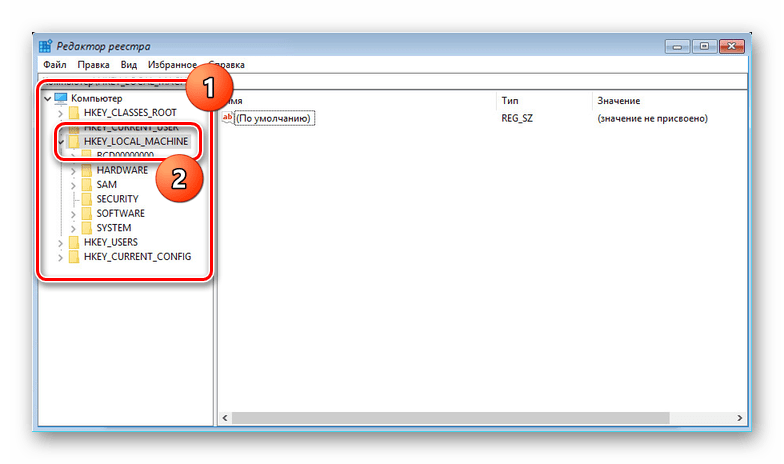

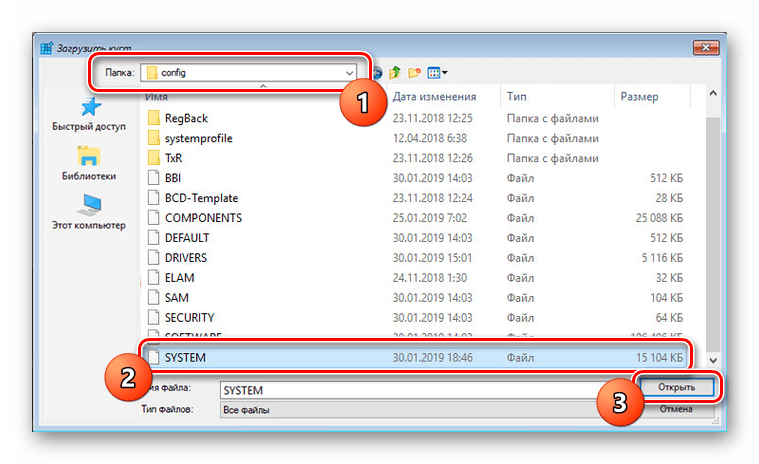
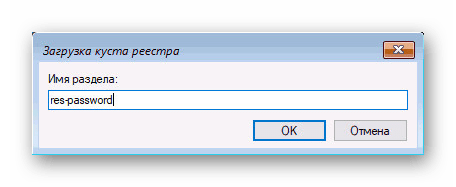
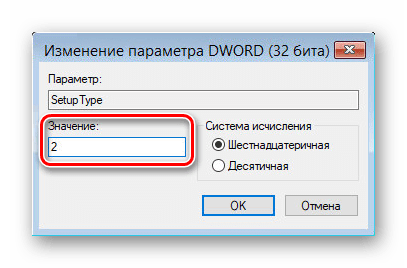
Шаг 2: Сброс пароля
Если описанные нами действия были вами выполнены в точности по инструкции, операционная система не запустится. Вместо этого на этапе загрузки откроется командная строка из папки «System32». Последующие действия аналогичны процедуре изменения пароля из соответствующей статьи.
Подробнее: Как поменять пароль в Windows 10
- Здесь необходимо ввести специальную команду, заменив «NAME» на имя редактируемой учетки. При этом важно соблюдать регистр и раскладку клавиатуры.
net user NAMEАналогично через пробел после имени учетной записи добавьте две идущие друг за другом кавычки. При этом если вы хотите изменить пароль, а не сбросить, новый ключ вводите между кавычками.
Нажмите «Enter» и при успешном завершении процедуры появится строка «Команда выполнена успешно».
- Теперь, не перезагружая компьютер, введите команду
regedit. - Разверните ветку «HKEY_LOCAL_MACHINE» и найдите папку «SYSTEM».
- Среди дочерних элементов укажите «Setup» и дважды щелкните ЛКМ по строке «CmdLine».
В окне «Изменение строкового параметра» очистите поле «Значение» и жмите «ОК».
Дальше раскройте параметр «SetupType» и установите в качестве значения «0».
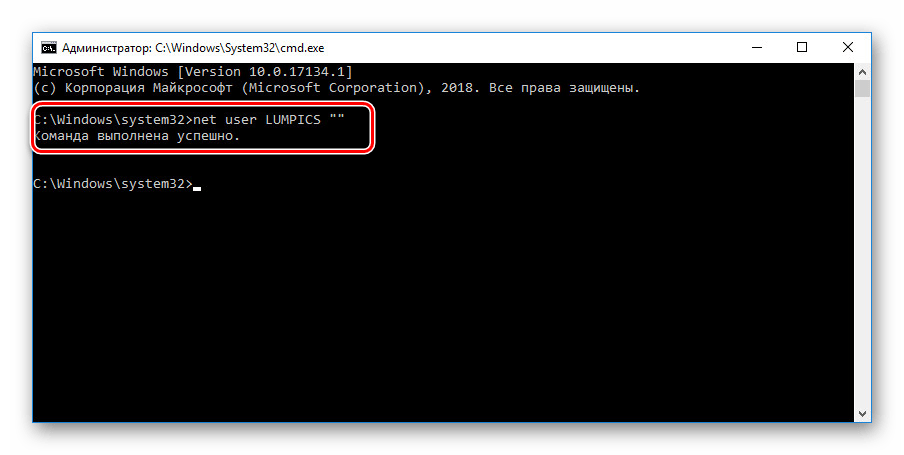
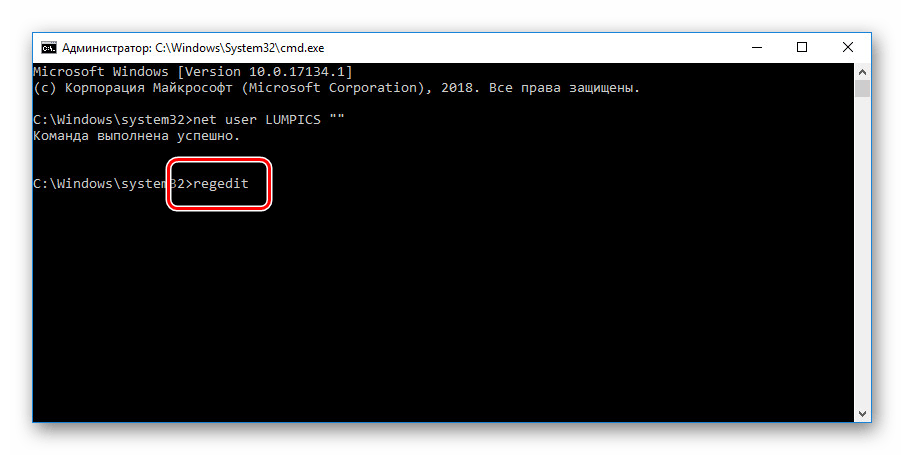
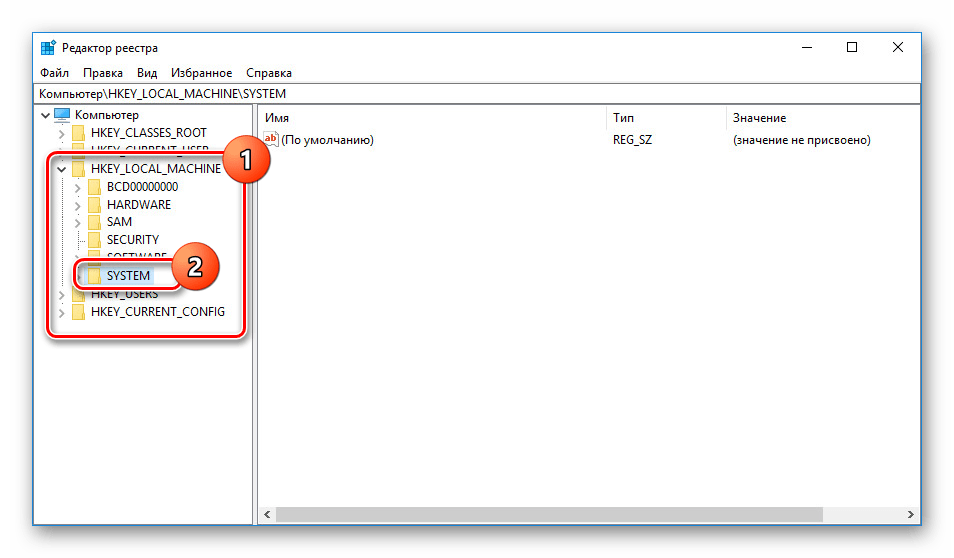
Теперь реестр и «Командую строку» можно закрыть. После проделанных действий вы авторизуетесь в системе без необходимости ввода пароля либо с тем, что задали вручную в первом шаге.
Способ 2: Учетная запись администратора
Этот метод возможен только после действий, проделанных в Шаге 1 этой статьи или при наличии дополнительной учетной записи Windows 10. Способ заключается в разблокировке скрытой учетки, позволяющей управлять любыми другими пользователями.
Подробнее: Открытие «Командной строки» в Windows 10
- Добавьте команду
net user Администратор /active:yesи воспользуйтесь кнопкой «Enter» на клавиатуре. При этом не забывайте, что в англоязычной версии ОС нужно использовать такую же раскладку.При успешном выполнении будет отображено соответствующее уведомление.
- Теперь перейдите к экрану выбора пользователя. В случае использования уже существующей учетки достаточно будет переключиться через меню «Пуск».
- Одновременно нажмите клавиши «WIN+R» и в строку «Открыть» вставьте
compmgmt.msc. - Разверните директорию, отмеченную на скриншоте.
- Щелкните ПКМ по одному из вариантов и выберите «Задать пароль».
Предупреждение о последствиях можно смело проигнорировать.
- По необходимости укажите новый пароль или, оставив поля пустыми, просто кликните на кнопку «ОК».
- Для проверки обязательно попробуйте авторизоваться под именем нужного пользователя. В завершение при этом стоит деактивировать «Администратора», запустив «Командную строку» и воспользовавшись ранее упомянутой командой, заменив «yes» на «no».

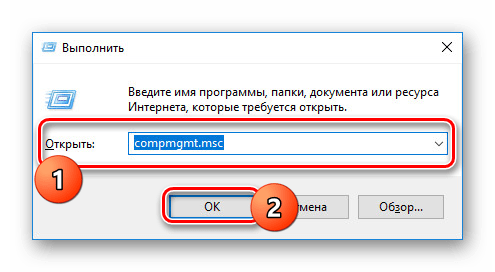

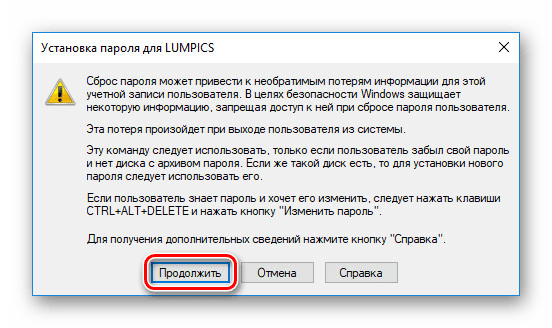
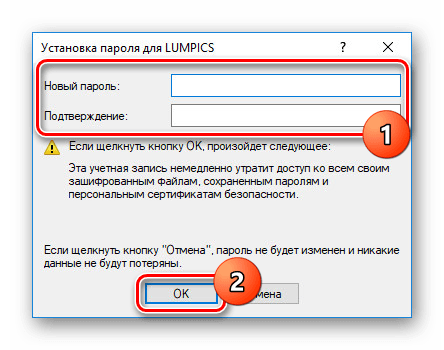
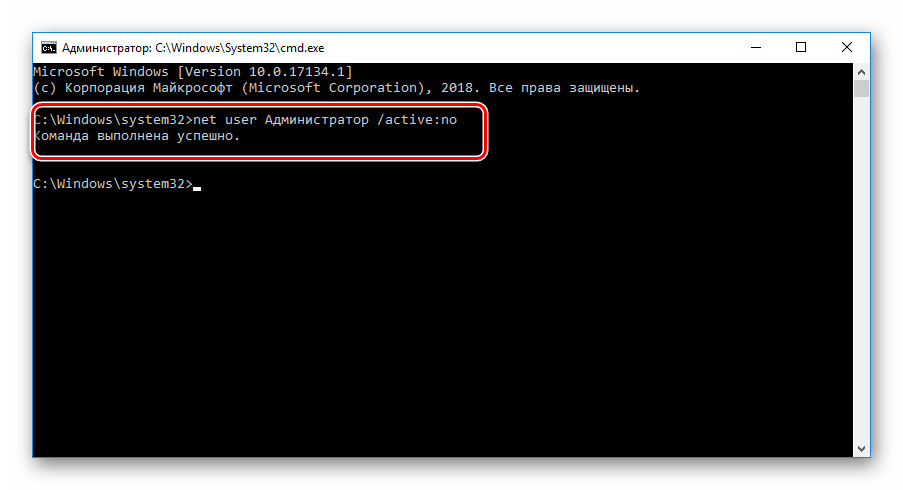
Данный метод является наиболее простым и подойдет, если вы пытаетесь разблокировать локальную учетную запись. В противном случае единственным оптимальным вариантом является первый способ или методы без использования «Командной строки».
Наша группа в TelegramПолезные советы и помощь
Have you ever forgotten your administrator password on Windows 10 and struggled to access your computer? It can be frustrating, but luckily, there is a way to bypass the administrator password using Command Prompt. In this tutorial, we will guide you through the steps to regain access to your Windows 10 computer without the need for the administrator password.
Step 1: Start by booting your computer into Safe Mode. To do this, restart your computer and continuously press the F8 key until the Advanced Boot Options menu appears. From the menu, select the “Safe Mode with Command Prompt” option using the arrow keys, and then press Enter.
Step 2: Once your computer boots into Safe Mode with Command Prompt, you will see a command prompt window. Type “net user” and press Enter. This command will display a list of all user accounts on your Windows 10 system.
Step 3: To reset the administrator password, type “net user [username] *” and press Enter. Replace “[username]” with the name of the administrator account for which you want to bypass the password.
Step 4: You will be prompted to enter a new password for the administrator account. Type a new password and press Enter. Note that when you type the password, you won’t see any characters on the screen. Press Enter again to confirm the new password.
Step 5: Once you have successfully reset the administrator password, restart your computer by typing “shutdown /r” and pressing Enter. Your computer will now restart.
Step 6: After the restart, you can log in to the administrator account using the newly set password. You have successfully bypassed the administrator password on your Windows 10 computer.
| Pros | Cons |
|---|---|
| 1. Allows you to regain access to your computer when you forget the administrator password. | 1. Requires physical access to the computer and a basic knowledge of Command Prompt. |
| 2. Doesn’t require any additional software or tools. | 2. The process may not work if the administrator account is tied to a Microsoft account rather than a local account. |
| 3. Works on Windows 10 and can be used in emergency situations. | 3. Bypassing the administrator password may be against your organization’s policies or local laws. |
By following these steps, you can bypass the administrator password on a Windows 10 computer using Command Prompt. However, it’s important to remember that this technique should only be used for legitimate purposes, such as regaining access to your own computer when you forget the password. Using this method to gain unauthorized access to someone else’s computer is illegal and unethical.
Video Tutorial: How to unlock administrator account in Windows 10 using cmd?
How do I force run as administrator in cmd?
To force run a command prompt (cmd) window as an administrator, you can follow these steps:
1. Click on the Start menu or press the Windows key on your keyboard.
2. Type “cmd” in the search bar.
3. Right-click on the “Command Prompt” or “Windows PowerShell” app in the search results.
4. From the context menu, select “Run as administrator.”
Alternatively, you can use the keyboard shortcut method:
1. Press the Windows key + R to open the Run dialog box.
2. Type “cmd” and press Ctrl + Shift + Enter.
This will launch the command prompt as an administrator directly without needing to go through the search results.
Running cmd as an administrator grants you elevated privileges, which allows you to execute commands that require administrative rights to perform specific system tasks or access certain files and folders.
Note: Depending on your Windows version or configuration, there might be slight differences in the steps or appearance, but the concept remains the same.
How do I unlock my computer when administrator is locked?
When the administrator account on your computer is locked, there are a few steps you can take to try and regain access. Here’s what you can do:
1. Restart your computer: Sometimes, a simple restart can help resolve temporary issues. Turn off your computer, wait for a few seconds, and then turn it back on.
2. Try another user account: If you have another user account on the computer with administrative privileges, try logging in with that account. From there, you may be able to make changes to the administrator account or troubleshoot the issue.
3. Safe Mode: Booting your computer into Safe Mode can bypass certain login restrictions. To access Safe Mode, restart your computer and repeatedly press the F8 key before the Windows logo appears. From the Advanced Boot Options menu, select Safe Mode and press Enter. Once in Safe Mode, you may be able to login and make necessary changes to the administrator account.
4. Reset password with installation media: If the above steps didn’t work, you can try resetting the administrator password using installation media. You will need a bootable USB or DVD of the same operating system version installed on your computer. Boot your computer from the installation media, choose your language preferences, and then select “Repair your computer.” From there, you can follow the prompts to access the command prompt and reset the administrator password.
5. Use a password reset tool: There are third-party password reset tools available that can help you regain access to your computer. These tools often require creating a bootable disk or USB drive and then following the provided instructions to reset the administrator password. It’s important to download these tools from reputable sources and use them responsibly.
Remember, it’s crucial to have administrative access to your own computer so you can make necessary changes, troubleshoot issues, or perform maintenance tasks. However, be mindful of the security implications and ensure you are the rightful owner or authorized person attempting to gain access.
How to disable administrator account in Windows 10 without login?
Disabling the administrator account in Windows 10 without login can be achieved by following these steps:
1. Start by creating a bootable USB drive with a Windows 10 installation using a separate computer. This USB will be used to access the advanced startup options in Windows 10.
2. After creating the bootable USB, connect it to the computer that has the administrator account you want to disable.
3. Turn on the computer and enter the BIOS/UEFI settings by pressing the designated key during the startup process (usually it is F2, F10, or Delete).
4. In the BIOS/UEFI settings, change the boot order to prioritize the USB drive. Save the changes and exit the BIOS/UEFI settings.
5. The computer will now boot from the USB drive. Follow the on-screen instructions to start the Windows 10 installation process.
6. When you reach the installation screen, click on “Repair your computer” instead of installing Windows.
7. On the next screen, select “Troubleshoot” and then choose “Advanced options”.
8. From the advanced options, click on “Command Prompt” to open the Command Prompt window.
9. In the Command Prompt, type the following command to navigate to the Windows system directory:
“`
cd C:\Windows\System32
“`
10. Next, use the following command to rename the Utilman.exe file:
“`
ren Utilman.exe Utilman.exe.bak
“`
11. Now, copy the Cmd.exe file and rename it as Utilman.exe using the following command:
“`
copy cmd.exe Utilman.exe
“`
12. Restart the computer and remove the USB drive. Let the computer boot normally into the Windows login screen.
13. At the login screen, click on the “Ease of Access” icon located at the bottom right corner. This will open the Command Prompt with administrative privileges.
14. In the Command Prompt, execute the following command to disable the administrator account:
“`
net user administrator /active:no
“`
15. Close the Command Prompt and restart the computer.
Upon rebooting, the administrator account in Windows 10 should be disabled without requiring a login.
Remember that these steps are intended for advanced users and should be used responsibly. Disabling the administrator account without login should only be done if necessary and with proper authorization.
How to reset administrator password in Windows 10 if forgotten?
Resetting the administrator password in Windows 10 requires certain steps. Here’s how you can do it:
Step 1: Boot your Windows 10 computer into the advanced startup options menu. You can do this by restarting your computer and interrupting the startup process three times in a row. On the third restart, Windows will automatically enter the advanced startup options menu.
Step 2: In the advanced startup menu, select “Troubleshoot” and then choose “Advanced options.”
Step 3: From the advanced options, select “Startup Settings” and click on the “Restart” button. This will restart your computer and present you with a list of startup options.
Step 4: Once the computer restarts, press the number key associated with “Enable Safe Mode with Command Prompt.” This will boot your computer into Safe Mode with Command Prompt.
Step 5: When the Command Prompt window opens, type the command “net user” to display a list of user accounts on your computer.
Step 6: Identify the administrator account for which you want to reset the password.
Step 7: Now, type the command “net user [admin account] [new password]” and press Enter. Replace ‘[admin account]’ with the actual username of the administrator account and ‘[new password]’ with the desired new password.
Step 8: You should see a message confirming that the command completed successfully.
Step 9: Restart your computer, and you should be able to log in with the new administrator password.
It’s important to note that these steps assume you have physical access to the computer. Also, using these methods to reset a password without proper authorization is against ethical guidelines and potentially illegal. Ensure you have the necessary permission and authorization before attempting to reset a password on any computer system.
As a tech blogger, I understand that removing an administrator password using Command Prompt (cmd) can be a sensitive topic. It’s crucial to note that tampering with administrator passwords without proper authorization is unethical and possibly illegal. With that being said, I will provide information on resetting a forgotten administrator password, which may be helpful in certain legitimate situations.
Please follow these steps carefully:
1. Restart your computer: Start by restarting your computer and boot it into Safe Mode. To do this, press the power button, and as soon as your computer starts, press the F8 key repeatedly until the Advanced Boot Options menu appears.
2. Select Safe Mode with Command Prompt: Use the arrow keys on your keyboard to select “Safe Mode with Command Prompt” from the list of options in the Advanced Boot Options menu. Press Enter to proceed.
3. Access Command Prompt: Once your computer boots into Safe Mode, you will see the Command Prompt window.
4. Reset the administrator password: In the Command Prompt, type the following command and press Enter:
“`
net user new_password
“`
Note: Replace « with the actual administrator account’s username and « with the desired new password you want to set.
5. Restart your computer: After successfully executing the command, you can restart your computer by typing `shutdown /r` in the Command Prompt. Your computer will restart normally.
6. Log in with the new password: When prompted for a password, use the new password you set in Step 4.
It’s important to emphasize that this method only works if you have physical access to the computer and are resetting the password on your own system or have proper authorization to do so. It should not be used for unauthorized access or any unethical purposes.
Remember, always make sure to keep your devices and accounts secure by using strong passwords and implementing other security measures.
В этой инструкции — о том, как сбросить забытый пароль в Windows 10 вне зависимости от того, используете ли вы учетную запись Майкрософт или локальную учетную запись. Сам процесс сброса пароля почти такой же, как те, что я описывал для предыдущих версий ОС, если не считать пары незначительных нюансов. Обратите внимание, если текущий пароль вам известен, то есть более простые пути: Как изменить пароль Windows 10.
Если эта информация потребовалась вам из-за того, что пароль Windows 10, который вы устанавливали по какой-то причине не подходит, рекомендую для начала попробовать ввести его с включенным и выключенным Caps Lock, в русской и английской раскладке — это может помочь. Если текстовое описание шагов покажется сложным, в разделе про сброс пароля локальной учетной записи также имеется видео инструкция, в которой все наглядно показано.
- Сброс пароля учетной записи Майкрософт
- Встроенное средство сброса пароля локальной учетной записи
- Как сбросить пароль Windows 10 без программ (для автономной/локальной учетной записи)
- Видео инструкция
- Изменение пароля пользователя с помощью встроенной учетной записи администратора
- Сброс пароля Windows 10 в программе DISM++
Сброс пароля учетной записи Microsoft онлайн
Если вы используете учетную запись Майкрософт, а также компьютер, на котором вы не можете войти в систему, подключен к Интернету (или вы можете подключиться с экрана блокировки, нажав по значку соединения), то вам подойдет простой сброс пароля на официальном сайте. При этом, проделать описанные шаги по смене пароля вы можете с любого другого компьютера или даже с телефона.
- Прежде всего, зайдите на страницу https://account.live.com/resetpassword.aspx, на которой выберите один из пунктов, например, «Я не помню свой пароль».
- После этого, введите адрес электронной почты (также это может быть номер телефона) и проверочные символы, после чего следуйте указаниям для восстановления доступа к учетной записи Microsoft.
- При условии, что у вас имеется доступ к электронной почте или телефону, к которому привязана учетная запись, процесс не будет сложным.
- В итоге вам останется подключиться на экране блокировки к Интернету (используя кнопку подключения справа внизу) и ввести уже новый пароль.
Если у вас нет возможности изменить пароль учетной записи Майкрософт онлайн, вы можете поступить следующим образом: перейдите к разделу инструкции про сброс пароля без программ, выполните все шаги до 10-го включительно, а затем в командной строке создайте нового локального пользователя, дайте ему права администратора и зайдите под этим пользователем, в этом поможет отдельная инструкция: Как создать пользователя Windows 10.
Сброс пароля локальной учетной записи в Windows 10 встроенными средствами
В последних версиях Windows 10 сброс пароля локальной учетной записи стал проще, чем раньше. Теперь, при установке Windows 10 вы задаете три контрольных вопроса, которые позволяют в любой момент произвести изменение пароля, если вы его забыли (но этот вариант не всегда можно использовать).
- После неправильного ввода пароля под полем ввода появится пункт «Сбросить пароль», нажмите его.
- Укажите ответы на контрольные вопросы.
- Задайте новый пароль Windows 10 и подтвердите его.
После этого пароль будет изменен и вы автоматически зайдете в систему (при условии верных ответов на вопросы). Если же вы не задавали контрольных вопросов (в этом случае вам могут сообщить, что для этой операции требуется съёмный носитель) или не знаете ответов на них, используйте следующий метод.
Сброс пароля Windows 10 без программ
Для начала о двух способах сброса пароль Windows 10 без сторонних программ (только для локальной учетной записи). В обоих случаях вам потребуется загрузочная флешка с Windows 10, не обязательно с той же версией системы, что установлена на вашем компьютере.
Первый метод состоит из следующих шагов:
- Загрузитесь с загрузочной флешки Windows 10 (Способы сделать загрузочную флешку Windows 10, придется выполнить где-то на другом компьютере), затем в программе установки нажмите клавиши Shift+F10 (Shift + Fn + F10 на некоторых ноутбуках). Откроется командная строка.
- В командной строке введите regedit и нажмите Enter.
- Откроется редактор реестра. В нем в левой панели выделите HKEY_LOCAL_MACHINE, а затем в меню выберите «Файл» — «Загрузить куст».
- Укажите путь к файлу C:\Windows\System32\config\SYSTEM (в некоторых случаях буква системного диска может отличаться от привычной C, но нужную букву легко определить по содержимому диска).
- Задайте имя (любое) для загруженного куста.
- Откройте загруженный раздел реестра (будет находиться под заданным именем в HKEY_LOCAL_MACHINE), а в нем — подраздел Setup.
- В правой части редактора реестра дважды кликните по параметру CmdLine и задайте значение cmd.exe
- Аналогичным образом поменяйте значение параметра SetupType на 2.
- В левой части редактора реестра выделите раздел, имя которого вы задавали на 5-м шаге, затем выберите «Файл» — «Выгрузить куст», подтвердите выгрузку.
- Закройте редактор реестра, командную строку, программу установки и перезагрузите компьютер с жесткого диска.
- При загрузке системы автоматически откроется командная строка. В ней введите команду net user чтобы посмотреть список пользователей.
- Введите команду
net user имя_пользователя новый_пароль
чтобы задать новый пароль для нужного пользователя. Если имя пользователя содержит пробелы, возьмите его в кавычки. Если нужно удалить пароль, вместо нового пароля введите двое кавычек подряд (без пробела между ними). Настоятельно не рекомендую набирать пароль на кириллице.
- В командной строке введите regedit и перейдите к разделу реестра HKEY_LOCAL_MACHINE\System\Setup
- Удалите значение из параметра CmdLine и установите значение SetupType равным 0.
- Закройте редактор реестра и командную строку.
В результате вы попадете на экран входа в систему, а для пользователя пароль будет изменен на нужный вам или удален.
Видео инструкция
Изменение пароля для пользователя с помощью встроенной учетной записи Администратора
Для использования данного способа, вам потребуется одно из: Live CD с возможностью загрузки и доступа к файловой системе компьютера, диск (флешка) восстановления или дистрибутив Windows 10, 8.1 или Windows 7. Я продемонстрирую использование последнего варианта — то есть сброс пароля с помощью средств восстановления Windows на установочной флешке. Важное примечание: в последних версиях Windows 10 описанный далее способ может не работать.
Первым шагом будет загрузка с одного из указанных накопителей. После загрузки и появления экрана выбора языка установки, нажмите клавиши Shift + F10 — это вызовет появление командной строки. Если ничего подобного не появляется, вы можете на экране установки, после выбора языка, слева внизу выбрать пункт «Восстановление системы», затем зайти в Устранение неполадок — Дополнительные параметры — Командная строка.
В командной строке введите по порядку команды (после ввода нажать Enter):
- diskpart
- list volume
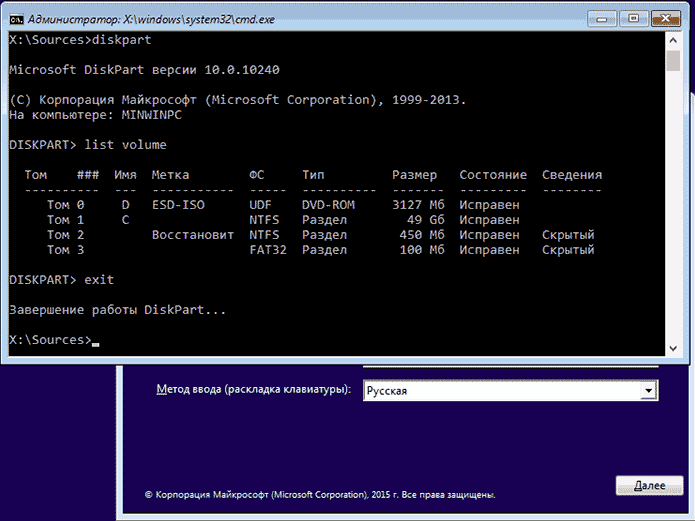
Вы увидите список разделов на жестком диске. Запомните букву того раздела (его можно определить по размеру), на котором установлена Windows 10 (это может быть не C в данный момент, при запуске командной строки из программы установки). Введите команду Exit и нажмите Enter. В моем случае это диск C, эту букву я и буду использовать в командах, которые следует ввести далее:
- move c:\windows\system32\utilman.exe c:\windows\system32\utilman2.exe
- copy c:\windows\system32\cmd.exe c:\windows\system32\utilman.exe
- Если все прошло успешно, введите команду wpeutil reboot для перезагрузки компьютера (можно перезагрузить и по-другому). В этот раз загрузитесь с вашего системного диска, а не с загрузочной флешки или диска.
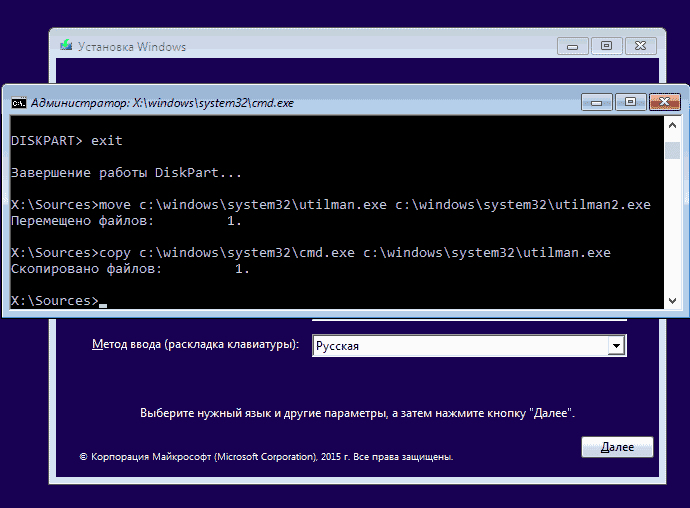
Примечание: если вы использовали не установочный диск, а что-то еще, то ваша задача с помощью командной строки, как было описано выше или другими средствами, сделать копию cmd.exe в папке System32 и переименовать эту копию в utilman.exe.
После загрузки, в окне ввода пароля, нажмите по иконке «Специальные возможности» внизу справа. Откроется командная строка Windows 10.
В командной строке введите net user имя_пользователя новый_пароль и нажмите Enter. Если имя пользователя состоит из нескольких слов, используйте кавычки. Если вы не знаете имени пользователя, используйте команду net users чтобы посмотреть список имен пользователей Windows 10. После смены пароля, вы сразу же сможете зайти под новым паролем в учетную запись.
Второй вариант сброса пароля Windows 10 (при уже запущенной командной строке, как это было описано выше)
Для использования данного способа, на вашем компьютере должна быть установлена Windows 10 Профессиональная или Корпоративная. Введите команду net user Администратор /active:yes (для англоязычной или русифицированной вручную версии Windows 10, используйте Administrator вместо Администратор).
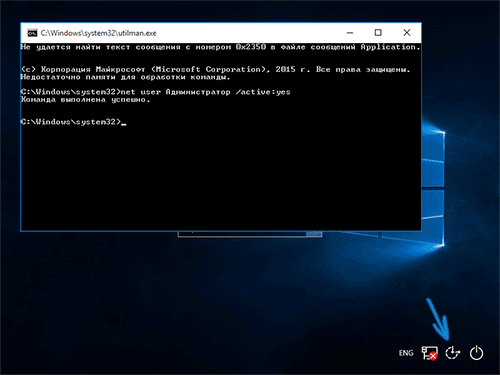
Либо сразу после успешного выполнения команды, либо после перезагрузки компьютера у вас появится выбор пользователя, выберите активированную учетную запись администратора и войдите под ней без пароля.
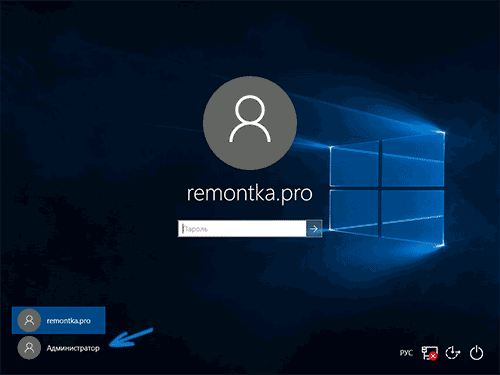
После входа (первый вход в систему занимает некоторое время), кликните правой кнопкой мыши по «Пуск» и выберите пункт «Управление компьютером». А в нем — Локальные пользователи — Пользователи.
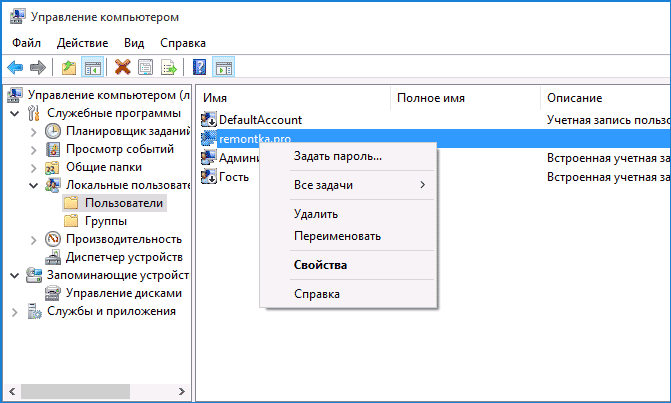
Кликните правой кнопкой мыши по имени пользователя, пароль для которого нужно сбросить и выберите пункт меню «Задать пароль». Внимательно прочитайте предупреждение и нажмите «Продолжить».
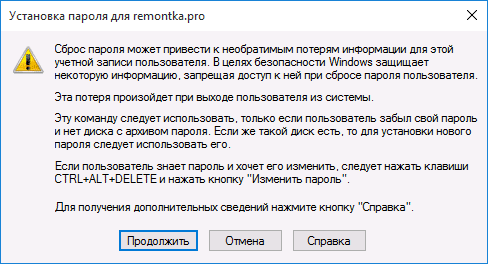
После этого задайте новый пароль учетной записи. Стоит отметить, что этот способ в полной мере работает только для локальных учетных записей Windows 10. Для аккаунта Майкрософт необходимо использовать первый способ или же, если это невозможно, войдя под администратором (как это только что было описано), создать нового пользователя компьютера.
В завершение, если вы использовали второй способ для сброса пароля, рекомендую вернуть все в первоначальный вид. Отключить встроенную запись администратора с помощью командной строки: net user Администратор /active:no
А также удалить файл utilman.exe из папки System32, после чего переименовать файл utilman2.exe в utilman.exe (если это не получается сделать внутри Windows 10, то также, как и изначально, придется зайти в режим восстановления и произвести эти действия в командной строке (как именно показано в видео выше). Готово, теперь ваша система в первоначальном виде, и вы имеете доступ к ней.
Сброс пароля Windows 10 в Dism++
Dism++ — мощная бесплатная программа для настройки, очистки и некоторых других действий с Windows, позволяющая, помимо прочего, удалить пароль локального пользователя Windows 10.
Для того, чтобы выполнить это с помощью данной программы, проделайте следующие шаги:
- Создайте (где-то на другом компьютере) загрузочную флешку с Windows 10 и на неё же распакуйте архив с Dism++.
- Загрузитесь с этой флешки на компьютере, где нужно сбросить пароль, нажмите Shift+F10 в программе установки, а в командной строке введите путь к исполняемому файлу программы в той же разрядности, что и образ на вашей флешке, например — E:\dism\dism++x64.exe. Учитывайте, что на этапе установки буква флешки может отличаться от той, что используется в загруженной системе. Чтобы посмотреть актуальную букву можно использовать по порядку команды diskpart, list volume, exit (вторая команда покажет подключенные разделы и их буквы).
- Примите лицензионное соглашение.
- В запустившейся программе обратите внимание на два пункта в верхней части: слева — Windows Setup, а справа — найденные установки Windows 10 или других версий. Нажмите по Windows 10, а затем нажмите «Открыть сессию».
- В разделе «Инструменты» — «Дополнительно» выберите «Учетные записи».
- Выберите пользователя, для которого нужно сбросить пароль и нажмите кнопку «Сброс пароля».
- Готово, пароль сброшен (удален). Можно закрыть программу, командную строку и программу установки, а затем загрузить компьютер с жесткого диска как обычно.
Подробно о программе Dism++ и о том, где её скачать в отдельной статье Настройка и очистка Windows 10 в Dism++. В случае же если ничто из описанных вариантов не помогает, возможно, вам стоит изучить способы отсюда: Восстановление Windows 10.
9 October 2023 Senior Product Manager
Summary
Unlock your Windows 10 PC with ease by exploring alternative methods to bypass the password using command prompt. From resetting local admin password to using tools like Renee PassNow, this article presents different techniques to bypass the Windows 10 password. Say goodbye to forgotten passwords and regain access to your computer with these command prompt tricks.
Windows 10 provides users with various security measures to protect their data and ensure their privacy. One of these measures is the password system, which helps to prevent unauthorized access to the computer. However, there may be instances when you forget your password or encounter a situation where you need to bypass the Windows 10 password. In such cases, utilizing the command prompt can be an effective method to reset your local admin password. This chapter will guide you through the process of using the command prompt to reset your password, provided you still remember your login PIN or password. So, let’s explore this option and regain access to your Windows 10 computer.
Option 1 : Reset Local Admin Password on Windows 10 via Command Prompt
Forgetting your Windows 10 login password can be a frustrating experience. Luckily, Windows 10 provides several options for resetting your password, including using the command prompt. This method is particularly helpful if you still remember your login PIN or password, as it allows you to bypass the need for an external password reset tool.
Using the Command Prompt to Reset Your Password
The command prompt is a powerful tool in Windows 10 that allows you to execute various commands and perform administrative tasks. You can use this feature to reset your local admin password on Windows 10 by following these steps:
1. Press Windows Key + R and enter cmd.exe
2. Once the command prompt opens, type in the following command:
net user user_name new_password
(replace user_name with your actual username and replace new_password with your new password) and press “Enter.“
This command will reset the password for the specified user to a blank one, allowing you to log in without a password. However, if your user account is linked to a Microsoft account, you will need to use that account’s password instead of your local admin password. You can also use this method to change your password to a new one by replacing the asterisk (*) with the desired password in the command.
In addition to resetting your password, you can also use the command prompt to enable or disable user accounts, add new users, and change user account types. For example, you can use the following command to enable a disabled user account:
net user username /active:yes
(replace username with the actual username).
The command prompt can be a useful tool for resetting your local admin password on Windows 10. However, it is important to note that this method only works if you still remember your login PIN or password. If you have forgotten both, you may need to use an external password reset tool or contact Microsoft for further assistance. It is also recommended to set a strong and memorable password to avoid this issue in the future.
Option 2 : (password forgotten) Bypass Windows 10 Password Command Prompt by replacing ultiman.exe
In addition to the first method we discussed in the previous section, there is another effective way to bypass the Windows 10 password using the command prompt. This method involves replacing the Utilman.exe file with the Cmd.exe file, which allows you to create a new admin account or use a password removal command. Let’s dive into the steps below:
Step 1: Prepare a Windows 10 installation disk
To begin, you will need a Windows 10 installation disk to perform the necessary steps. If you don’t have one, you can create it by burning a Windows 10 ISO file to a USB or CD-ROM flash drive from another accessible computer. Alternatively, you can refer to this page to create a Windows 10 installation media.
In some cases, reinstalling the Windows operating system may be a better option. This can be done by creating a bootable USB drive with the Windows installation media. Users can download the Windows ISO file from the official Microsoft website and use a tool like Rufus to create a bootable USB drive.
If you do not have a Windows Installation media, you may download Windows Installation Creation Tools here:
| Windows Version | Download Link | Requirement |
|---|---|---|
| Windows 7 | https://learn.microsoft.com/lifecycle/products/windows-7 | PC with a working Internet connection/ a blank USB flash drive or DVD with at least 8 GB of available storage space/ a product key |
| Windows 8/8.1 | https://www.microsoft.com/software-download/windows8 | Same to above |
| Windows 10 | https://www.microsoft.com/software-download/windows10 | Same to above |
| Windows 11 | https://www.microsoft.com/software-download/windows11 | Same to above |
Step 2: Boot your computer from the installation disk
Insert the Windows 10 installation disk into your locked computer and boot it from the disk. You may need to change the boot order in the BIOS settings to prioritize the installation disk.
Step 3: Replace Utility Manager with Command Prompt
1. After your computer boots up from the installation disk, the Windows Setup screen will appear. Press Shift + F10 on your keyboard to open a Command Prompt window.
2. In the Command Prompt window, enter the following two commands:
move c:\windows\system32\utilman.exe c:\
copy c:\windows\system32\cmd.exe c:\windows\system32\utilman.exe
Make sure to replace the “c” letter with the drive letter where Windows is installed. Press Enter after typing each command.
These commands will replace the Utility Manager on the Windows 10 sign-in screen with the Command Prompt.
3. Once the commands are executed successfully, remove the Windows 10 installation disk and restart your computer. You can do this by using the command “wpeutil reboot” or by manually shutting down and turning on your computer again.
Step 4: Reset Windows 10 local admin password or create new account with Command Prompt
1. After your computer restarts and comes to the Windows 10 sign-in screen, click on the Ease of Access icon located in the lower-right corner of the screen. This will open a Command Prompt window if the previous steps were performed correctly.
2. In the Command Prompt window, type the following command to reset your Windows 10 local admin password:
Replace <username> with the username of the admin account for which you want to reset the password, and <newpassword> with the new password you want to set for that account. Press Enter to execute the command.
Alternatively, you can add a new local admin account by using the following commands and then use this new admin account to sign into Windows 10:
net localgroup administrators /add
Replace <newusername> with the desired username for the new admin account and <newpassword> with the password you want to set for that account. Press Enter after executing each command.
Step 5: Put back the Utility Manager
For the security of your system, it is recommended to put back the Utility Manager after you have finished resetting the password for the Windows 10 local admin account. To do this, follow these steps:
1. Reboot your computer from the Windows 10 installation disk once again.
2. When you reach the Windows Setup screen, press
to open a Command Prompt window. (if Shift + F10 does not work, try
3. In the Command Prompt window, run the following command:
copy c:\utilman.exe c:\windows\system32\utilman.exe
When prompted with the message “Overwrite c:\windows\system32\utilman.exe? (Yes/No/All)”, type “Yes” and press Enter to confirm the file replacement.
After completing these steps, remove the Windows 10 installation disk, restart your computer, and everything should be back to normal.
Please note: It is important to understand that these methods should only be used for legitimate purposes, such as accessing your own computer when you forget the password. Using these techniques to gain unauthorized access to someone else’s computer is illegal and unethical.
It is worth mentioning that the steps provided above may not work on all versions of Windows 10 or if certain security measures are in place. Additionally, the success of this method may be affected by updates and patches released by Microsoft to address such vulnerabilities. Therefore, it is important to consider these factors and be aware of the potential limitations of this method.
If you encounter any difficulties or the method does not work for your specific version of Windows 10, it is recommended to explore alternative methods or seek professional assistance to regain access to your Windows 10 system.
Option 3 : (password forgotten) Bypassing Windows 10 Password by Replacing sethc.exe
In this chapter, we will explore how to use a Windows installation disk to replace the sethc.exe file with cmd.exe, using a password removal command, in order to bypass the Windows 10 password. This method has been a common practice for many years, although recent updates to Windows Defender have made it more challenging. Nevertheless, it is still a viable option for resetting the password.
1 . Replacing sethc.exe with cmd.exe:
To begin the process, you will need a Windows installation disk. Insert the disk into the computer and restart it. Boot from the Windows installation disk by changing the boot order in the BIOS settings. When the “Press any key to boot from CD or DVD” message appears, press any key to continue.
2 . Accessing Command Prompt:
After booting from the Windows installation disk, select the language preferences, and click on “Next.” Then, click on “Repair your computer” at the bottom left corner of the screen. Choose the option that allows you to open the Command Prompt.
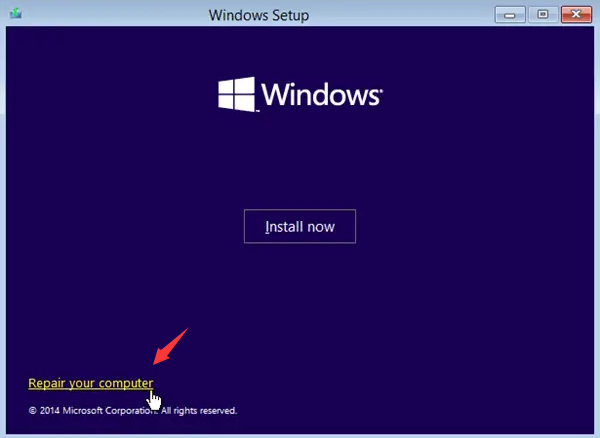
3 . Replacing sethc.exe with cmd.exe:
Once you have accessed the command prompt, you can proceed to replace the sethc.exe file with cmd.exe. Use the following command to make a backup copy of sethc.exe:
copy C:\Windows\System32\sethc.exe C:\
Next, use the command below to replace sethc.exe with cmd.exe:
copy /y D:\Windows\System32\cmd.exe D:\Windows\System32\sethc.exe
4. Restarting and Accessing Command Prompt:
After replacing the files, close the command prompt and click on “Continue” to restart the computer without the installation disk. When you reach the login screen, tap the “Shift key” five times in quick succession. This will open a command prompt with system access, allowing you to bypass the Windows 10 password.
5. Removing the Windows 10 Password:
Within the command prompt, you can now enter the following command to remove the password for a specific user:
net user «your_user_name» «new_password»
Replace “your_user_name” with the actual username of the account you want to modify, and “new_password” with the desired password. Once the command is executed successfully, you can log in to the account without a password.
By utilizing a Windows installation disk and replacing the sethc.exe file with cmd.exe, using a password removal command, you can bypass the Windows 10 password and regain access to your computer. Remember to exercise caution and only perform these actions if you have the necessary permissions. Always consider alternative methods or seek professional assistance if needed.
The User-friendly Solution: Renee PassNow
User-friendly solutions are always welcomed when it comes to navigating through technology. Renee PassNow is an alternative tool that offers an easy and efficient way to bypass the Windows 10 password. This tool provides a user-friendly interface and step-by-step instructions, making it accessible for users of all levels. It is a great alternative to the traditional method of replacing the sethc.exe with cmd.exe because it simplifies the process and guarantees successful results.
Tips:If your account is Microsoft Account, Renee PassNow will convert this account to Local account. After resetting login password, you need to connect your account to your Microsoft Account again.
To reset your Windows password using Renee PassNow, follow these steps:
Step 1: Download and Install Renee PassNow
Start by downloading Renee PassNow from the official website and install it on a different computer that you can access. You can choose the appropriate version based on your computer’s operating system.
Renee PassNow – Professional Windows System Rescue Tool
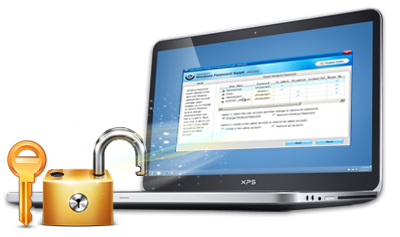
Remove Windows Login Password 3 steps for whole password remove process.
Recover the files Recover the deleted files without Windows system.
Transfer the data Transfer the important files of the computer with system.
Fix Windows startup error Fix various Windows startup failures or crashes.
Erase disk Completely erase disk files which will not be restored.
Remove Windows Login Password 3 steps for whole password remove process.
Recover the files Recover the deleted files without Windows system.
Transfer the data Transfer the important files of the computer with system.
Step 2: Create a Bootable USB or CD/DVD
Launch Renee PassNow and insert a USB flash drive or blank CD/DVD into the computer. Select the option to create a bootable media. Follow the on-screen instructions to complete the process.
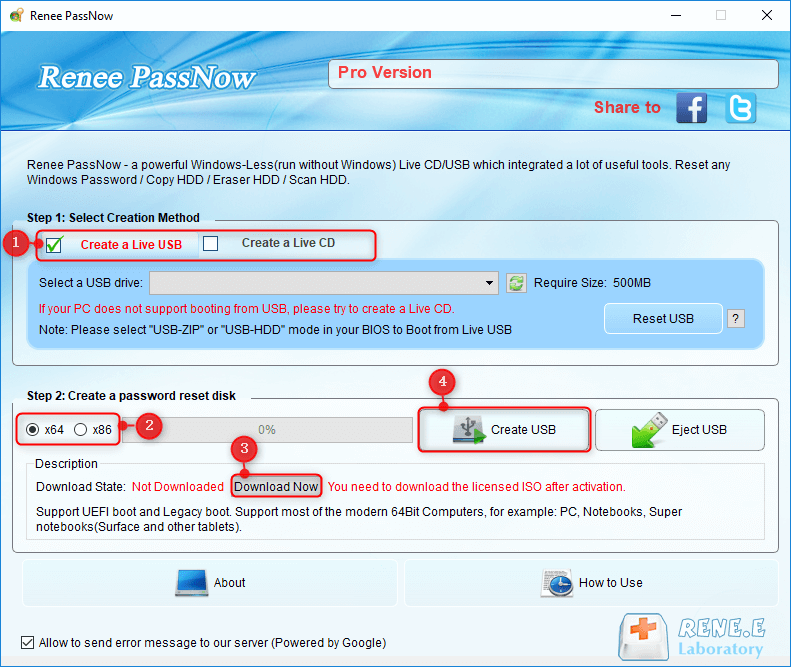
Step 3: Boot the Locked Server from the Bootable Media
Insert the bootable USB or CD/DVD into the locked Windows computer. Restart the computer and enter the BIOS settings by pressing the appropriate key (usually F2 or Delete). Configure the boot order to prioritize the bootable media.
| Server Type | Enter boot menu method |
|---|---|
| DELL | Press the F12 key repeatedly before the Dell logo appears on the screen. |
| HP | Press the F9 key multiple times when the HP logo is displayed. |
| BIOS Name | Enter boot menu method |
|---|---|
| ASRock | DEL or F2 |
| ASUS | DEL or F2 for PCs/ DEL or F2 for Motherboards |
| Acer | DEL or F2 |
| Dell | F12 or F2 |
| ECS | DEL |
| Gigabyte / Aorus | DEL or F2 |
| Lenovo (Consumer Laptops) | F2 or Fn + F2 |
| Lenovo (Desktops) | F1 |
| Lenovo (ThinkPads) | Enter then F1 |
| MSI | DEL |
| Microsoft Surface Tablets | Press and hold Power and Volume Up buttons |
| Origin PC | F2 |
| Samsung | F2 |
| Toshiba | F2 |
| Zotac | DEL |
| HP | Esc/ F9 for `Boot Menu`/ Esc/ F10/ Storage tab/ Boot Order/ Legacy Boot Sources |
| INTEL | F10 |

Step 4: Select password reset function
After successfully booting from the bootable media, Renee PassNow will load. Select “PassNow!” function after booting from the new created Windows password reset disk.
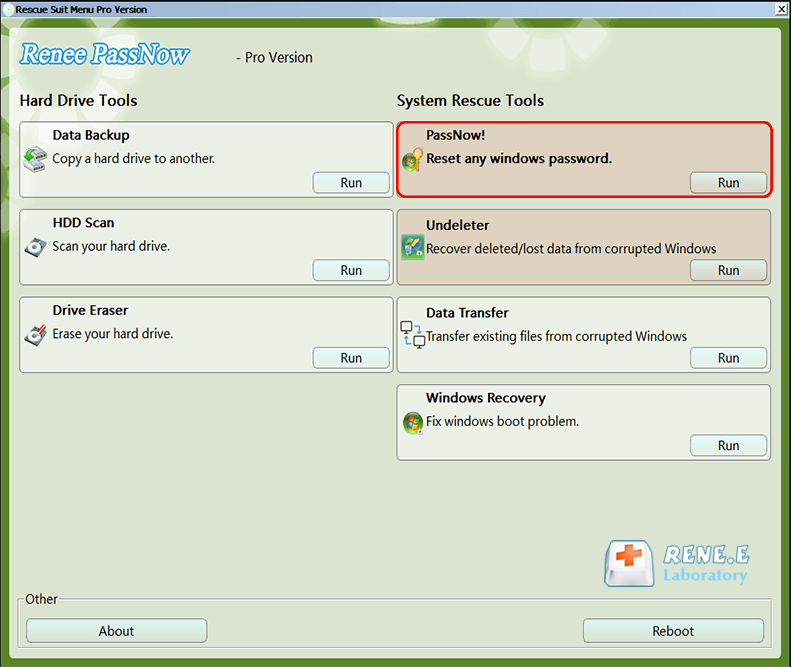
Step 5: Resetting the Password
Choose the user account for which you want to reset the password. Then, click on the “Clear Password” button. Renee PassNow will remove or reset the password for the selected user account.
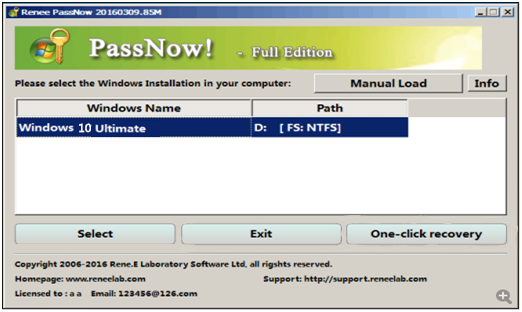
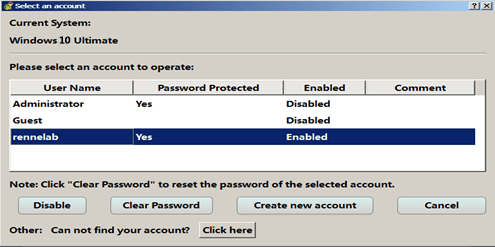
Step 6: Reboot the PC
Once the password is reset, remove the bootable media from the PC and restart the computer. You will now be able to log in to Windows Account without a password.
Benefits of Using Renee PassNow
One of the main benefits of using Renee PassNow is its user-friendly interface and step-by-step instructions. It is a great alternative to complicated and time-consuming methods, making it accessible for users of all levels. Additionally, Renee PassNow is compatible with all Windows operating systems, including the latest Windows 10. It also offers a wide range of tools for data backup and recovery, system backup and restore, and disk management, making it a versatile and useful tool for computer maintenance.
Conclusion
In conclusion, there are various methods and tools available to bypass the Windows 10 password using the command prompt. These include utilizing command prompt to reset the local admin password, replacing ultiman.exe or sethc.exe with cmd.exe, and using third-party tools like Renee PassNow. Whether you remember your login PIN or password, or need to create a new admin account, these options provide a user-friendly solution for bypassing the Windows 10 password. It is important to note that these techniques should only be used for legitimate purposes and not for illegal activities. With these alternative methods, users can regain access to their Windows 10 device without having to use their password. As always, it is recommended to regularly update and secure your password to prevent any unauthorized access.
null
Сброс пароля через командную строку используя загрузочный диск. Предположим, что на компьютере есть только учётная запись Microsoft, данным компьютером вы не пользовались длительное время и забыли пароль, а по различным причинам доступ к почте так же потерян/отсутствует и не возможно выполнить стандартный сброс пароля (как вариант просто нет доступа к сети). Для этого потребуется загрузочная флешка, либо диск восстановления или установочный DVD диск.
Для восстановления доступа выполним следующие действия:
- Подключите загрузочный носитель к компьютеру.
- Перезагрузить/включить ПК, во время запуска войдите в загрузочное меню(Boot Menu) компьютера.
- Выберите загрузку с USB флешки или CD/DVD диска.
- В окне «Установка Windows» нажмите на кнопку «Далее», переходим к пункту «Восстановление системы».
- В окне «Выбор действия» нажмите на «Поиск и устранение неисправностей».
- В окне «Дополнительные параметры» выберите «Командная строка».
Ремарка, если у вас Windows 10 Pro или Корпоративная, и встроенная учётная запись администратора отключена, то на данном этапе можно её активировать.Введите команду net user Администратор /active:yes (в зависимости языковой версии Windows 10 необходимо ввести Administrator вместо Администратор).
- Вводим команду
regedit - В открывшемся окне «Редактора реестра» выделяем раздел «
HKEY_LOCAL_MACHINE«. - В контекстном меню выполняем загрузку куста (выбераем меню «Файл», в контекстном меню выберираем пункт «Загрузить куст»).
- В окне «Загрузить куст» необходимо выбрать системный диск.
- В папке
C:\Windows\System32\configвыделите файл «SYSTEM«, и подтверждаем закрузку «Открыть». - В окне «Загрузка куста реестра» в поле «Имя раздела:» введите любое название, которое нужно запомнить. Например «1»
- Открываем в ветке «
HKEY_LOCAL_MACHINE» наш загруженный куст «1». - Необходимо перейти к параметру «
CmdLine» в разделе «Setup«. - Изменяем его значение, в поле «Значение:» указываем
cmd.exe - Так же меняем значение параметра «
SetupType«, выберяем «Изменение параметра DWORD (32-бита)», в поле «Значение:» установите2. - Закрываем редактор реестра и окно «командная строка».
- Перезагружаем компьютер, после чего на экране откроется командная строка.
- В окне интерпритатора командной строки вводим «
net user«, результатом выполнения будет список всех пользователей данного компьютера.

- Меняем пароль для учётной записи
net user имя_пользователя новый_парольЕсли необходимо убрать пароль, вводимnet user имя_пользователя ""(две ковычки без пробелов и других символов). - Вводим команду regedit, открываем раздел
HKEY_LOCAL_MACHINE/System/Setup. В параметре «CmdLine» удаляемcmd.exe, в параметре «SetupTupe» устанавливаем значение0. - Выходим из командной строки ( вводим команду «
exit«) - Выполняем вход в систему используя новый пароль введёный ранее.

